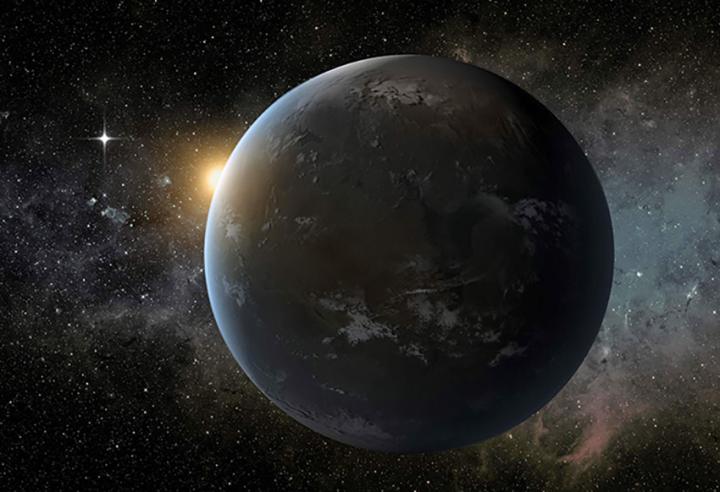

An artist's rendering of an exoplanet is shown. An exoplanet is a planet that exists outside Earth's solar system.
Illustration credit: NASA/Ames/JPL-Caltech
Is there anybody out there? The question of whether Earthlings are alone in the universe has puzzled everyone from biologists and physicists to philosophers and filmmakers. It's also the driving force behind San Francisco State University astronomer Stephen Kane's research into exoplanets — planets that exist outside Earth's solar system.
As one of the world's leading “planet hunters,” Kane focuses on finding “habitable zones,” areas where water could exist in a liquid state on a planet's surface if there's sufficient atmospheric pressure. Kane and his team, including former undergraduate student Miranda Waters, examined the habitable zone on a planetary system 14 light years away. Their findings will appear in the next issue of Astrophysical Journal in a paper titled “Characterization of the Wolf 1061 Planetary System.”
“The Wolf 1061 system is important because it is so close and that gives other opportunities to do follow-up studies to see if it does indeed have life,” Kane said.
But it's not just Wolf 1061's proximity to Earth that made it an attractive subject for Kane and his team. One of the three known planets in the system, a rocky planet called Wolf 1061c, is entirely within the habitable zone. With assistance from collaborators at Tennessee State University and in Geneva, Switzerland, they were able to measure the star around which the planet orbits to gain a clearer picture of whether life could exist there.
When scientists search for planets that could sustain life, they are basically looking for a planet with nearly identical properties to Earth, Kane said. Like Earth, the planet would have to exist in a sweet spot often referred to as the “Goldilocks zone” where conditions are just right for life.
Simply put, the planet can't be too close or too far from its parent star. A planet that's too close would be too hot. If it's too far, it may be too cold and any water would freeze, which is what happens on Mars, Kane added.
Conversely, when planets warm, a “runaway greenhouse effect” can occur where heat gets trapped in the atmosphere. Scientists believe this is what happened on Earth's twin, Venus. Scientists believe Venus once had oceans, but because of its proximity to the sun the planet became so hot that all the water evaporated, according to NASA. Since water vapor is extremely effective in trapping in heat, it made the surface of the planet even hotter. The surface temperature on Venus now reaches a scalding 880 degrees Fahrenheit.
Since Wolf 1061c is close to the inner edge of the habitable zone, meaning closer to the star, it could be that the planet has an atmosphere that's more similar to Venus. “It's close enough to the star where it's looking suspiciously like a runaway greenhouse,” Kane said.
Kane and his team also observed that unlike Earth, which experiences climatic changes such as an ice age because of slow variations in its orbit around the sun, Wolf 1061c's orbit changes at a much faster rate, which could mean the climate there could be quite chaotic. “It could cause the frequency of the planet freezing over or heating up to be quite severe,” Kane said.
These findings all beg the question: Is life possible on Wolf 1061c? One possibility is that the short time scales over which Wolf 1061c's orbit changes could be enough that it could actually cool the planet off, Kane said. But fully understanding what's happening on the planet's surface will take more research.
In the coming years, there will be a launch of new telescopes like the James Webb Space Telescope, the successor to the Hubble Space Telescope, Kane said, and it will be able to detect atmospheric components of the exoplanets and show what's happening on the surface.















